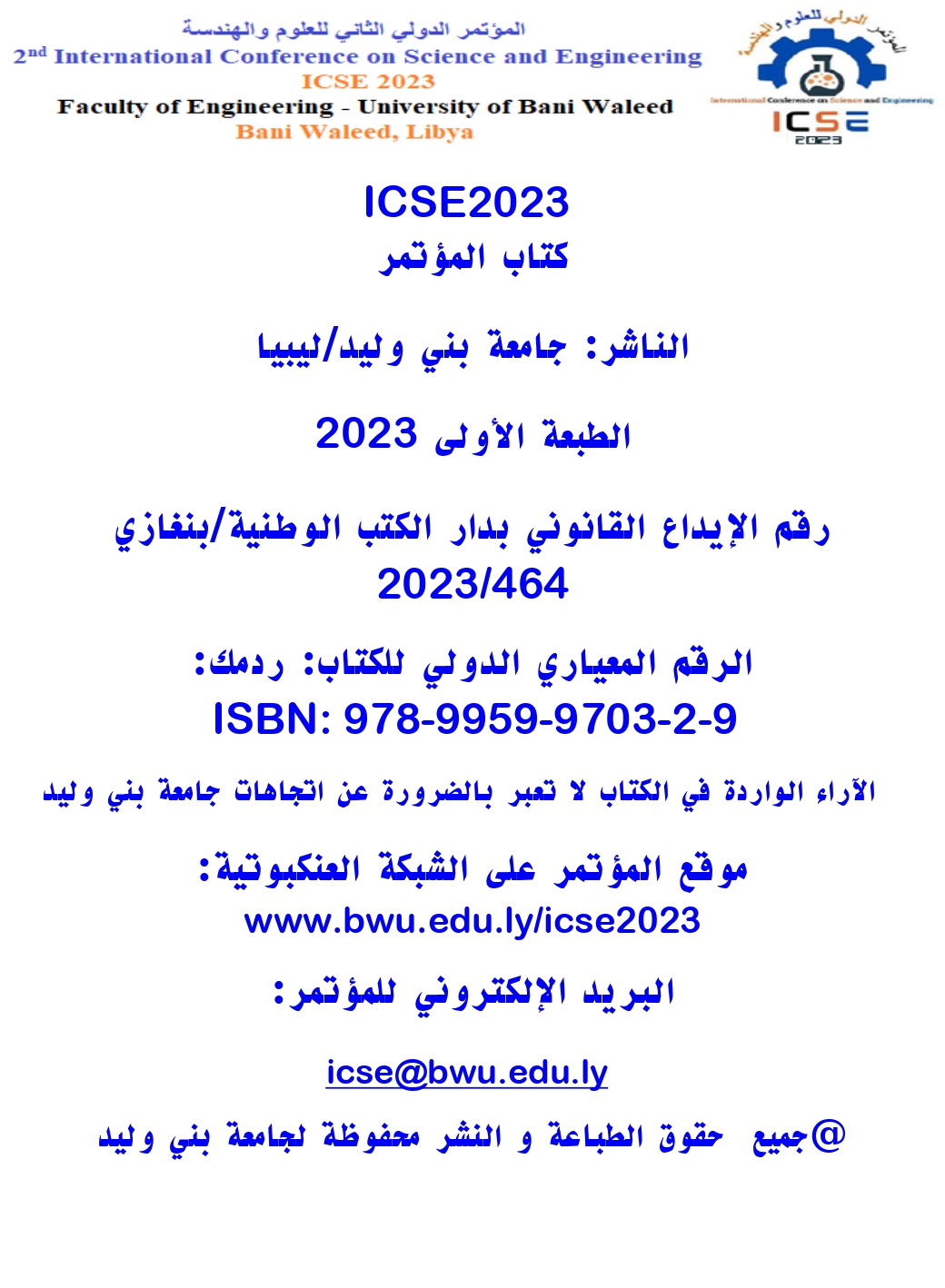Molecular Docking, DFT, MEPs and in Vitro Investigations of Ni(II), Pd(II) and Cu(II) complexes containing thiosemicarbazone moiety
DOI:
https://doi.org/10.58916/jhas.v8i3.147Keywords:
3-Acetylpyridine, Thiosemicarbazone, Microbiological screening, Molecular dockingAbstract
Abstract: Metal complexes of 3-acetylpyridine thiosemicarbazone ligand (3-APT) with Ni(II), Cu(II), and Pd(II) chlorides were screened against bacterial strains Staphylococcus aureus, Bacillus subtilis, Escherichia coli and Pseudomonas aeruginosa. Cytotoxic activities showed that the Pd (II) complex exhibited more effective cytotoxic activity against human breast cancer cell line MCF-7 with (IC50=20.72 μg/ml. The nucleophilic and electrophilic location interactions in the investigated ligand were described using the molecular electrostatic potential (MEPs) map. The density functional theory (DFT) was also carried out. Molecular docking investigation displayed the interactions between the active site amino acids of ribosyltransferase with the studied complexes. Besides, the cytotoxic modes of action by the active chelates with epidermal growth factor receptor tyrosine kinase were studied.
Downloads
References
Garcı́a-Tojal, J., et al., Biological activity of complexes derived from thiophene-2-carbaldehyde thiosemicarbazone. Crystal structure of [Ni (C6H6N3S2) 2]. 2001. 86(2-3): p. 627-633.
Prabhakaran, R., et al., Structural and biological studies of mononuclear palladium (II) complexes containing N-substituted thiosemicarbazones. 2008. 43(2): p. 268-273.
Rodríguez-Argüelles, M.C., et al., Copper complexes of imidazole-2-, pyrrole-2-and indol-3-carbaldehyde thiosemicarbazones: inhibitory activity against fungi and bacteria. 2005. 99(11): p. 2231-2239.
West, D.X., S.B. Padhye, and P.B. Sonawane, Structural and physical correlations in the biological properties of transition metal heterocyclic thiosemicarbazone and S-alkyldithiocarbazate complexes, in Complex Chemistry. 2005, Springer. p. 1-50.
Green, M.A., et al., In vivo quantitative whole-body perfusion imaging using radiolabeled copper (II) bis (thiosemicarbazone) complexes and positron emission tomography (PET). 2022: p. 751-771.
Patil, S.A., et al., Comprehensive Review on Medicinal Applications of Coumarin-Derived Imine–Metal Complexes. 2022. 27(16): p. 5220.
Vashi, K. and H.J.J.o.C. Naik, Synthesis of novel Schiff base and azetidinone derivatives and their antibacterial activity. 2004. 1: p. 272-275.
Pelosi, G.J.T.O.C.J., Thiosemicarbazone metal complexes: from structure to activity. 2010. 3(1).
Matesanz, A.I., I. Leitao, and P.J.J.o.I.B. Souza, Palladium (II) and platinum (II) bis (thiosemicarbazone) complexes of the 2, 6-diacetylpyridine series with high cytotoxic activity in cisplatin resistant A2780cisR tumor cells and reduced toxicity. 2013. 125: p. 26-31.
Milewski, S., H. Chmara, and E.J.A.o.m. Borowski, Antibiotic tetaine—a selective inhibitor of chitin and mannoprotein biosynthesis in Candida albicans. 1986. 145: p. 234-240.
Čobeljić, B., et al., Analysis of the structures of the Cu (I) and Cu (II) complexes with 3-acetylpyridine and thiocyanate. 2014. 69: p. 77-83.
Mendes, I., et al., Structural and spectral studies of thiosemicarbazones derived from 3-and 4-formylpyridine and 3-and 4-acetylpyridine. 2001. 559(1-3): p. 355-360.
Alwi, M.A.M., et al., Gravimetric and electrochemical statistical optimizations for improving copper corrosion resistance in hydrochloric acid using thiosemicarbazone-linked 3-acetylpyridine. 2022. 12(43): p. 27793-27808.
El-Ayaan, U.J.J.o.C.C., Transition metal complexes of 3-acetylpyridine 4 N-(2-pyridyl) thiosemicarbazone (HAPS); structural, spectroscopic, and biological studies. 2012. 65(4): p. 629-642.
Becke, A.D.J.T.J.o.c.p., Density‐functional thermochemistry. I. The effect of the exchange‐only gradient correction. 1992. 96(3): p. 2155-2160.
Zheng, G., et al., Gaussian 09. 2009: p. 48.
Al-Janabi, A.S., et al., Spectroscopic, anti-bacterial, anti-cancer and molecular docking of Pd (II) and Pt (II) complexes with (E)-4-((dimethylamino) methyl)-2-((4, 5-dimethylthiazol-2-yl) diazenyl) phenol ligand. 2023. 27(3): p. 101619.
]18] Biemer, J.J.J.A.o.C. and L. Science, Antimicrobial susceptibility testing by the Kirby-Bauer disc diffusion method. 1973. 3(2): p. 135-140.
]19] Hassan, S.S.J.A.O.C., Antibacterial, DFT and molecular docking studies of Rh (III) complexes of Coumarinyl‐Thiosemicarbazone nuclei based ligands. 2018. 32(3): p. e4170.
Ali, A., et al., Ligand substituent effect on the cytotoxicity activity of two new copper (ii) complexes bearing 8-hydroxyquinoline derivatives: Validated by MTT assay and apoptosis in MCF-7 cancer cell line (human breast cancer). 2021. 11(24): p. 14362-14373.
Abdelaziz, A., et al., Ag (I), In (III), and Sn (II) chelates of azo mesalamine drug: Characterization, DFT studies, molecular docking and biological evaluation. 2023. 37(2): p. e6944.
Salama, S.K., et al., Molecular docking simulation and anticancer assessment on human breast carcinoma cell line using novel bis (1, 4-dihydropyrano [2, 3-c] pyrazole-5-carbonitrile) and bis (1, 4-dihydropyrazolo [4′, 3′: 5, 6] pyrano [2, 3-b] pyridine-6-carbonitrile) derivatives. 2017. 71: p. 19-29.
De Gianni, E. and C. Fimognari, Anticancer mechanism of sulfur-containing compounds, in The Enzymes. 2015, Elsevier. p. 167-192.
Pal, S.J.P., Pyridine: A useful ligand in transition metal complexes. 2018. 57: p. 57-74.
Wang, H., et al., A computational study of adsorption and activation of CO2 and H2 over Fe (1 0 0) surface. 2016. 15: p. 107-114.









